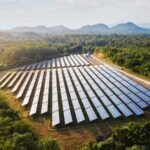In the dynamic landscape of global energy, the conversation is shifting. While fossil fuels have long dominated, the rise of renewable energy sources, particularly solar power, is reshaping the narrative. Companies like Steelbridge Export are at the forefront of this transformation, recognizing the economic and environmental advantages of solar energy.
A Comparative Analysis of Solar Energy Costs vs. Fossil Fuels (2025)
This article delves into a comprehensive comparison between solar energy and fossil fuels in 2025, highlighting cost dynamics, technological advancements, and the role of innovative models like the EPCF model.
The Declining Costs of Solar Energy
Over the past decade, solar energy has witnessed a significant reduction in costs. The levelized cost of electricity (LCOE) for solar photovoltaic (PV) systems has decreased by over 90% since 2010 . In 2023 alone, solar PV’s global costs were 56% lower than those of fossil fuels and nuclear power . This trend is attributed to advancements in technology, economies of scale, and increased manufacturing efficiency.
Fossil Fuels: Hidden and Ongoing Costs
While fossil fuels have historically been perceived as cost-effective, this perspective often overlooks hidden expenses. Substantial subsidies, environmental degradation, and health impacts contribute to the true cost of fossil fuel consumption. In 2023, global fossil fuel subsidies were estimated at $7 trillion annually . Additionally, the volatility of fossil fuel prices, influenced by geopolitical tensions and market fluctuations, poses economic risks.

The EPCF Model: Streamlining Solar Projects
The EPCF model—encompassing Engineering, Procurement, Construction, and Financing—has emerged as a pivotal framework in solar energy projects. By integrating these components, the EPCF model facilitates efficient project execution, reduces risks, and attracts investment. This approach is particularly beneficial in large-scale solar installations, where coordinated efforts are essential for timely and cost-effective completion.
Comparative Cost Analysis: Solar vs. Fossil Fuels
In 2025, the cost of electricity generation presents a compelling case for solar energy:
Solar PV: 4.0 cents per kilowatt-hour (kWh)
Onshore Wind: 4.4 cents/kWh
Natural Gas: 12.9 cents/kWh
Coal: 11.4 cents/kWh
These figures underscore the economic advantage of renewable energy sources, particularly solar power, over traditional fossil fuels.
more to read: The Geopolitical Significance of Mineral Exports in the Gulf Region
Environmental and Health Considerations
Beyond financial metrics, solar energy offers substantial environmental and health benefits. The life-cycle greenhouse gas emissions of solar PV are significantly lower than those of coal and natural gas . Reducing reliance on fossil fuels mitigates air pollution, decreases greenhouse gas emissions, and promotes public health.

Global Trends and Future Outlook
The global shift towards renewable energy is evident. In 2023, 81% of newly commissioned, utility-scale renewable projects had lower costs than their fossil fuel-fired alternatives . Countries are increasingly adopting policies and incentives to promote renewable energy adoption, further accelerating this transition.
Conclusion
The comparative analysis of solar energy and fossil fuels in 2025 reveals a clear trajectory towards renewable energy dominance. With declining costs, environmental benefits, and supportive frameworks like the EPCF model, solar power stands as a viable and advantageous alternative to fossil fuels. As the energy landscape continues to evolve, stakeholders must embrace these changes to foster a sustainable and economically sound future. For more insights and resources, visit epc
FAQs: Solar Energy vs. Fossil Fuels (2025)
- 1. Why is solar energy becoming more cost-effective than fossil fuels?
Solar energy costs have decreased significantly due to technological advancements, economies of scale, and improved manufacturing efficiency. These factors have driven the levelized cost of electricity (LCOE) for solar PV down by over 90% since 2010, making solar highly competitive against fossil fuels. - 2. What role does the EPCF model play in solar energy projects?
The EPCF model integrates Engineering, Procurement, Construction, and Financing into a cohesive framework, enabling efficient coordination and risk mitigation. This model streamlines project delivery, reduces costs, and attracts investment, particularly for large-scale solar installations. - 3. How do hidden costs affect the economic comparison between fossil fuels and solar energy?
Fossil fuels incur substantial hidden costs including subsidies, environmental damage, and health-related expenses. These costs are often excluded from direct price comparisons, meaning fossil fuels are more expensive to society than their market price suggests. - 4. What environmental benefits does solar energy offer compared to fossil fuels?
Solar energy generates significantly lower greenhouse gas emissions across its lifecycle compared to coal and natural gas. It reduces air pollution, mitigates climate change impact, and supports healthier communities. - 5. How are global trends influencing the adoption of solar energy over fossil fuels?
Globally, increasing numbers of renewable energy projects have lower costs than fossil fuel alternatives. Policy incentives, climate commitments, and technological progress are accelerating the shift toward solar and other clean energy sources.








